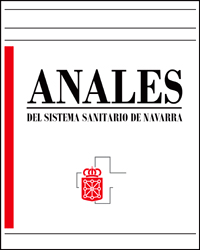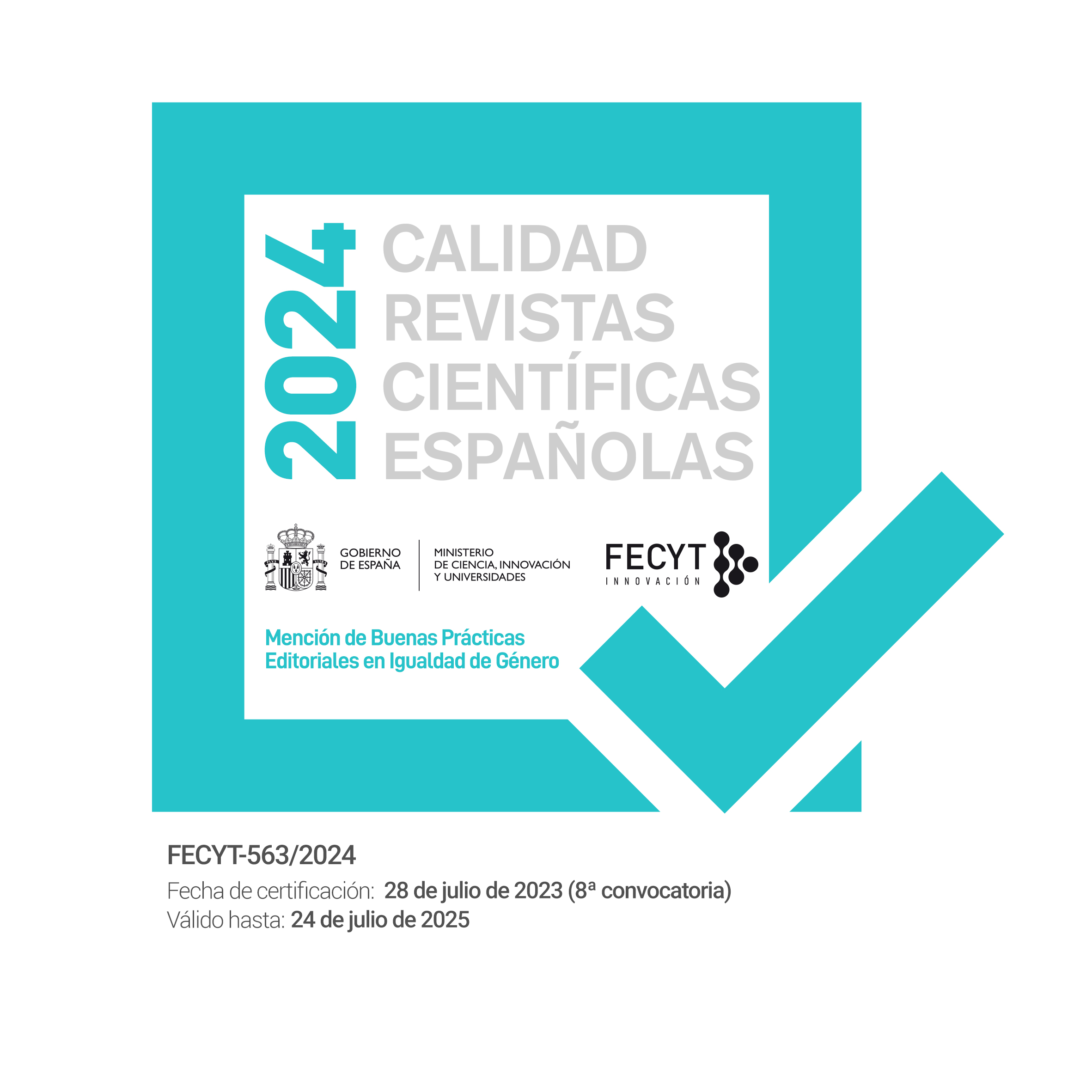Impacto de la anestesia libre de opioides en cirugía bariátrica
DOI:
https://doi.org/10.23938/ASSN.0757Palabras clave:
Opioides. Cirugía baríatrica. Dolor postoperatorio. Recuperación postanestésica.Resumen
Fundamento. Los pacientes sometidos a cirugía bariátrica presentan mayor riesgo de complicaciones debido al uso de opioides. El objetivo es valorar la seguridad e idoneidad del protocolo Anestesia libre de opioides (OFA) implantado en el Hospital Universitario Virgen de la Victoria en 2018.
Material y métodos. Estudio prospectivo llevado a cabo en 38 pacientes sometidos a cirugía bariátrica laparoscópica bajo protocolo OFA durante el año 2018 en el H.U. Virgen de la Victoria (Málaga). Se recogieron variables para establecer el control hemodinámico y del dolor perioperatorio que se analizaron mediante Stata v.16.
Resultados. La edad media fue 43 años, el índice de masa corporal medio 48,14 y la estancia media en quirófano 178 minutos. El control de la respuesta hipertensiva tras la laringoscopia sucedió en el 88,1% de los casos. Al ingreso en la Unidad de Recuperación Post Anestésica (URPA), la SpO2 sin aporte suplementario en el traslado presentó una mediana de 97% con p75 ≥ 95%, mientras que el p75 de la evaluación del dolor mediante escala visual analógica (EVA) fue 3, con un 68% de pacientes sin dolor. Al alta de URPA, todos presentaron EVA menor de 4 y solo fue necesario administrar una dosis baja de petidina en siete pacientes.
Conclusión. La OFA ha resultado ser segura y conseguir un control del dolor óptimo. En los casos reconvertidos, el buen control de los parámetros abre la posibilidad de su utilización en cirugías más dolorosas.
Descargas
Citas
ODERDA GM, SAID Q, EVANS RS, STODDARD GJ, LLOYD J, JACKSON K et al. Opioid-related adverse drug events in surgical hospitalizations: impact on costs and length of stay. Ann Pharmacother 2007; 41: 400-407. https://doi.org/10.1345/aph.1H386
WEINBROUM AA. Role of anaesthetics and opioids in perioperative hyperalgesia. Eur J Anaesthesiol 2015; 32: 230-231. https://doi.org/10.1097/EJA.0000000000000231
FUNK RD, HILLIARD P, RAMACHANDRAN SK. Perioperative opioid usage. Plast Reconstr Surg 2014; 134: 32S-39S. https://doi.org/10.1097/prs.0000000000000680
MULIER JP. Perioperative opioids aggravate obstructive breathing in sleep apnea syndrome. Curr Opin Anaesthesiol 2016; 29: 129-133. https://doi.org/10.1097/aco.0000000000000281
DHONNEUR G, COMBES X, LEROUX B, DUVALDESTIN P. Postoperative obstructive apnea. Anesth Analg 1999; 89: 762-767. https://doi.org/10.1097/00000539-199909000-00045
BENUMOF JL. Obstructive sleep apnea in the adult obese patient: implications for airway management. J Clin Anesth 2001; 13: 144-156. https://doi.org/10.1016/s0952-8180(01)00232-x
GOLD AR, GOLD MS, HARRIS KW, ESPELETA VJ, AMIN MM, BRODERICK JE. Hypersomnolence, insomnia and the pathophysiology of upper airway resistance syndrome. Sleep Med 2008; 9: 675-683. https://doi.org/10.1016/j.sleep.2007.08.013
ROSE DK, COHEN MM, WIGGLESWORTH DF, DEBOER DP. Critical respiratory events in the Postanesthesia Care Unit. Anesthesiology 1994; 81: 410-418. https://doi.org/10.1097/00000542-199408000-00020
BERCAULT N, BOULAIN T, KUTEIFAN K, WOLF M, RUNGE I, FLEURY JC. Obesity-related excess mortality rate in an adult intensive care unit: a risk-adjusted matched cohort study. Crit Care Med 2004; 32: 998-1003. https://doi.org/10.1097/01.ccm.0000119422.93413.08
GUPTA RM, PARVIZI J, HANSSEN AD, GAY PC. Postoperative complications in patients with obstructive sleep apnea syndrome undergoing hip or knee replacement: a case-control study. Mayo Clin Proc 2001; 76: 897-905. https://doi.org/10.4065/76.9.897
TURAN A, YOU J, EGAN C, FU A, KHANNA A, ESHRAGHI Y et al. Chronic intermittent hypoxia is independently associated with reduced postoperative opioid consumption in bariatric patients suffering from sleep-disordered breathing. PLoS One 2015; 10: e0127809. https://doi.org/10.1371/journal.pone.0127809
GALLAGHER SF, HAINES KL, OSTERLUND LG, MULLEN M, DOWNS JB. Postoperative hypoxemia: common, undetected, and unsuspected after bariatric surgery. J Surg Res 2010; 159: 622-626. https://doi.org/10.1016/j.jss.2009.09.003
AHMAD S, NAGLE A, MCCARTHY RJ, FITZGERALD PC, SULLIVAN JT, PRYSTOWSKY J. Postoperative hypoxemia in morbidly obese patients with and without obstructive sleep apnea undergoing laparoscopic bariatric surgery. Anesth Analg 2008; 107: 138-143. https://doi.org/10.1213/ane.0b013e318174df8b
World Health Organization. Global status report on alcohol and health 2014. Poznyak V, Rekve D, editors. Luxembourg: World Health Organization, 2014. https://apps.who.int/iris/bitstream/handle/10665/112736/9789240692763_eng.pdf?sequence=1
NG M, FLEMING T, ROBINSON M, THOMSON B, GRAETZ N, MARGONO C et al. Global, regional, and national prevalence of overweight and obesity in children and adults during 1980–2013: a systematic analysis for the Global Burden of Disease Study 2013. Lancet 2014; 384: 766-781. https://doi.org/10.1016/S0140-6736(14)60460-8
BERRINGTON DE GONZALEZ A, HARTGE P, CERHAN JR, FLINT AJ, HANNAN L, MACINNIS RJ et al. Body-mass index and mortality among 1.46 million white adults. N Engl J Med 2010; 363: 2211-2219. https://doi.org/10.1056/NEJMoa1000367
BUCHWALD H, AVIDOR Y, BRAUNWALD E, JENSEN MD, PORIES W, FAHRBACH K et al. Bariatric surgery. JAMA 2004; 292: 1724. https://doi.org/10.1001/jama.292.14.1724
CHRISTOU NV, SAMPALIS JS, LIBERMAN M, LOOK D, AUGER S, MCLEAN APH et al. Surgery decreases long-term mortality, morbidity, and health care use in morbidly obese patients. Ann Surg 2004; 240: 416-424. https://doi.org/10.1097/01.sla.0000137343.63376.19
THORELL A, MACCORMICK AD, AWAD S, REYNOLDS N, ROULIN D, DEMARTINES N et al. Guidelines for perioperative care in bariatric surgery: enhanced recovery after surgery (ERAS) society recommendations. World J Surg 2016; 40: 2065-2083. https://doi.org/10.1007/s00268-016-3492-3
MAŁCZAK P, PISARSKA M, PIOTR M, WYSOCKI M, BUDZYŃSKI A, PĘDZIWIATR M. Enhanced recovery after bariatric surgery: systematic review and meta-analysis. Obes Surg 2017; 27: 226-235. https://doi.org/10.1007/s11695-016-2438-z
PIERRE S, BENAIS H, POUYMAYOU J. Apfel’s simplified score may favourably predict the risk of postoperative nausea and vomiting. Can J Anesth 2002; 49: 237-242. https://doi.org/10.1007/bf03020521
VEIGA-GIL L, PUEYO J, LÓPEZ-OLAONDO L. Náuseas y vómitos postoperatorios: fisiopatología, factores de riesgo, profilaxis y tratamiento . Rev Esp Anestesiol Reanim 2017; 64: 223-232. https://doi.org/10.1016/j.redar.2016.10.001
HALLIDAY TA, SUNDQVIST J, HULTIN M, WALLDÉN J. Post-operative nausea and vomiting in bariatric surgery patients: an observational study. Acta Anaesthesiol Scand 2017; 61: 471-479. https://doi.org/10.1111/aas.12884
RAVESLOOT MJL, VAN MAANEN JP, HILGEVOORD AAJ, VAN WAGENSVELD BA, DE VRIES N. Obstructive sleep apnea is underrecognized and underdiagnosed in patients undergoing bariatric surgery. Eur Arch Oto-Rhino-Laryngology 2012; 269: 1865-1871. https://doi.org/10.1007/s00405-012-1948-0
YOUNG T, PEPPARD PE, TAHERI S. Excess weight and sleep-disordered breathing. J Appl Physiol 2005; 99: 1592-1599. https://doi.org/10.1152/japplphysiol.00587.2005
SAMUELS D, ABOU-SAMRA A, DALVI P, MANGAR D, CAMPORESI EM. Opioid-free anesthesia results in reduced post-operative opioid consumption. J Clin Anesth Pain Med 2017; 1: 005.
BHARDWAJ S, GARG K, DEVGAN S. Comparison of opioid-based and opioid-free TIVA for laparoscopic urological procedures in obese patients. J Anaesthesiol Clin Pharmacol 2019; 35: 481-486. https://doi.org/10.4103/joacp.joacp_382_18
FELD JM, LAURITO CE, BECKERMAN M, VINCENT J, HOFFMAN WE. Non-opioid analgesia improves pain relief and decreases sedation after gastric bypass surgery. Can J Anesth 2003; 50: 336-341. https://doi.org/10.1007/bf03021029
SALEM AM, HAFEZ MML, ELDIN AS, HAGRAS AM. Opioid-free anesthesia for laparoscopic hysterectomy: is it appropriate? J Anesth Inten Care Med 2019; 9: 555757. https://doi.org/10.19080/JAICM.2019.09.555757
MULIER JP, WOUTERS R, DILLEMANS B, DEKOCK M. A randomized controlled, double-blind trial evaluating the effect of opioid-free versus opioid general anaesthesia on postoperative pain and discomfort measured by the QoR-40. J Clin Anesth Pain Med 2018; 2: 015.
HAKIM KYK, WAHBA ZWB. Opioid-free total intravenous anesthesia improves postoperative quality of recovery after ambulatory gynecologic laparoscopy. Anesth Essays Res 2019; 13: 199-203. https://doi.org/10.4103/aer.aer_74_19
LAM KKY, MUI WLM. Multimodal analgesia model to achieve low postoperative opioid requirement following bariatric surgery. Hong Kong Med J 2016; 22 : 428-434. https://doi.org/10.12809/hkmj154769
BAKAN M, UMUTOGLU T, TOPUZ U, UYSAL H, BAYRAM M, KADIOGLU H et al. Anestesia venosa total livre de opioides, com infusões de propofol, dexmedetomidina e lidocaína para colecistectomia laparoscópica: Estudo prospectivo, randomizado e duplo-cego. Rev Bras Anestesiol 2015; 65: 191-199. https://doi.org/10.1016/j.bjane.2014.05.001
ZIEMANN-GIMMEL P, GOLDFARB AA, KOPPMAN J, MAREMA RT. Opioid-free total intravenous anaesthesia reduces postoperative nausea and vomiting in bariatric surgery beyond triple prophylaxis. Br J Anaesth 2014; 112: 906-911. https://doi.org/10.1093/bja/aet551
TAYLOR S, KIRTON OC, STAFF I, KOZOL RA. Postoperative day one: a high risk period for respiratory events. Am J Surg 2005; 190: 752-756. https://doi.org/10.1016/j.amjsurg.2005.07.015
MULIER JP, DILLEMANS B. Anaesthetic factors affecting outcome after bariatric surgery, a retrospective levelled regression analysis. Obes Surg 2019; 29: 1841-1850 https://doi.org/10.1007/s11695-019-03763-1
DÍAZ-CRESPO J, MALO-MANSO A, BUSTAMANTE-DOMÍNGUEZ C, ESCALONA-BELMONTE JJ, CRUZ-MAÑAS J, GUERRERO-ORRIACH JL. Laparotomy in a patient under opioid-free anaesthesia. An Sist Sanit Navar 2018; 41: 259-262. https://doi.org/10.23938/ASSN.0294
Publicado
Cómo citar
Número
Sección
Licencia
Derechos de autor 2020 Anales del Sistema Sanitario de Navarra

Esta obra está bajo una licencia internacional Creative Commons Atribución-CompartirIgual 4.0.
La revista Anales del Sistema Sanitario de Navarra es publicada por el Departamento de Salud del Gobierno de Navarra (España), quien conserva los derechos patrimoniales (copyright ) sobre el artículo publicado y favorece y permite la difusión del mismo bajo licencia Creative Commons Reconocimiento-CompartirIgual 4.0 Internacional (CC BY-SA 4.0). Esta licencia permite copiar, usar, difundir, transmitir y exponer públicamente el artículo, siempre que siempre que se cite la autoría y la publicación inicial en Anales del Sistema Sanitario de Navarra, y se distinga la existencia de esta licencia de uso.








